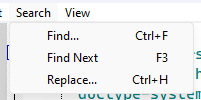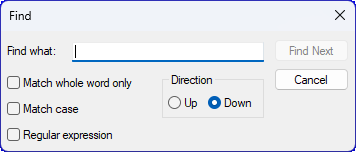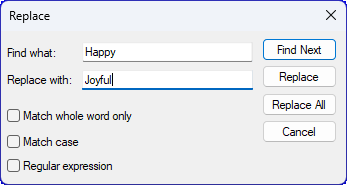Search

The Search menu in provides essential tools for locating and modifying text.
Let's explore how to use these features:
Find
Quickly locate specific words or phrases within your document.
Press Ctrl+F to open the search bar, then type the text you're looking for.

This is the standard Find dialog box that is commonly used in text editors, word processors, and web browsers to search for specific words or phrases within a document or webpage.
Here’s how to use it:
- Find what
Enter the word or phrase you want to search for in this field. - Match whole word only
Check this option if you want to find exact matches of the whole word only. - Match case
Enable this option to make your search case-sensitive. - Regular expression
Use this option if you are searching using regular expressions. - Direction
Choose between Up and Down options depending on whether you want to search from your current cursor position upwards or downwards through the document. - Find Next
Click this button to find the next occurrence of your specified word/phrase.
Find Next
After entering the search term, use this option or press F3 to jump to the next occurrence of the specified text.
Replace
Substitute one word or phrase with another.
Press Ctrl+H to open a dialog box where you can specify the text to find and its replacement.

This is the Replace dialog box commonly found in text editors or word processors. This function is used to substitute specific words or phrases within a document with alternatives.
Here’s how to use it:
- Find what
Enter the word or phrase you want to replace. In this example, "Happy" is being replaced. - Replace with
Enter the new word or phrase that you want to substitute for the original. Here, "Happy" will be replaced with "Joyful". - Match whole word only
Select this option if you want to replace only whole occurrences of the word and not parts of other words. - Match case
Choose this if you want the replacement to be case-sensitive. - Regular expression
Use this option for complex replacements involving patterns.
Click Find Next to move through each occurrence one by one, deciding whether to replace it or not, or Replace All to substitute every occurrence throughout the document.
What are Regular Expressions?A regular expression, often shortened to regex, is a special kind of search string. Instead of looking for an exact word or phrase, it can find any text that follows a certain pattern. Imagine you're looking for all your emails that mention a specific product. You could search for the exact product name, but what if there are typos or different variations? A regex can find all emails that include any version of the product name, like "ph0ne" or "super-phone1000." Here are some key things about regex:
Regex can seem complex at first, but there are tools online to help you build and test them before using them for real. |
